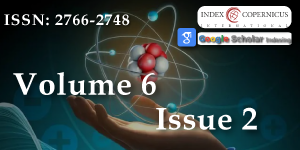The Stability and Behaviour of the Superposition of Non-Linear Waves in Space
Main Article Content
Abstract
The superposition of non-linear waves in space refers to the phenomenon where two or more waves overlap and combine to form a new wave pattern. Non-linear waves are characterized by their ability to interact with each other, leading to complex behaviors that are not observed in linear wave systems. Understanding the stability and behavior of the superposition of non-linear waves in space is crucial in various fields such as physics, engineering, and oceanography.
When non-linear waves superpose, their interactions can lead to a range of behaviors, including wave breaking, formation of solitons (localized wave packets), and the generation of harmonics. The stability of the superposition is determined by the balance between the non-linear effects and dispersive effects, which can either stabilize or destabilize the wave pattern. In addition, the behavior of non-linear waves in space is influenced by external factors such as boundaries, dissipation, and external forcing.
In this paper, we study the behavior and characteristics of waves when they interact with each other. Superposition refers to the phenomenon where multiple waves combine to form a resultant wave. In the case of linear waves, this superposition occurs according to the principles of linear superposition, which states that the displacement or amplitude at any point is the algebraic sum of the displacements or amplitudes of the individual waves.
Understanding the superposition of linear waves in space has various applications in fields such as physics, engineering, acoustics, optics, and signal processing. By studying how waves interact and combine, researchers can gain insights into wave propagation, interference patterns, wave reflections, diffraction, and other phenomena that occur when waves meet.
Article Details
Copyright (c) 2023 Adeogun CO.

This work is licensed under a Creative Commons Attribution 4.0 International License.
The International Journal of Physics Research and Applications is committed in making it easier for people to share and build upon the work of others while maintaining consistency with the rules of copyright. In order to use the Open Access paradigm to the maximum extent in true terms as free of charge online access along with usage right, we grant usage rights through the use of specific Creative Commons license.
License: Copyright © 2017 - 2025 |  Open Access by International Journal of Physics Research and Applications is licensed under a Creative Commons Attribution 4.0 International License. Based on a work at Heighten Science Publications Inc.
Open Access by International Journal of Physics Research and Applications is licensed under a Creative Commons Attribution 4.0 International License. Based on a work at Heighten Science Publications Inc.
With this license, the authors are allowed that after publishing with the journal, they can share their research by posting a free draft copy of their article to any repository or website.
Compliance 'CC BY' license helps in:
| Permission to read and download | ✓ |
| Permission to display in a repository | ✓ |
| Permission to translate | ✓ |
| Commercial uses of manuscript | ✓ |
'CC' stands for Creative Commons license. 'BY' symbolizes that users have provided attribution to the creator that the published manuscripts can be used or shared. This license allows for redistribution, commercial and non-commercial, as long as it is passed along unchanged and in whole, with credit to the author.
Please take in notification that Creative Commons user licenses are non-revocable. We recommend authors to check if their funding body requires a specific license.
Boyd RW. Nonlinear optics (3rd ed.). Academic Press. (Print). 2008.
Akhmediev N, Ankiewicz A. Solitons: Nonlinear pulses and beams. Chapman & Hall/CRC. (Print). 2005.
Kivshar YS, Agrawal GP. Optical solitons: From fibers to photonic crystals. Academic Press. (Print). 2003.
Hasegawa A, Tappert F. Transmission of stationary nonlinear optical pulses in dispersive dielectric fibers: I. Anomalous dispersion. Applied Physics Letter. 1973; 23(3): 142-144. doi:10.1063/1.1654836 (Web)
Dudley J, Coen S. Supercontinuum generation in photonic crystal fiber (2nd ed.). Cambridge University Press. (Print). 2019.
Andrews DL, Babiker M. The angular momentum of light. Cambridge University Press. (Print). 2003.
Kevrekidis PG, Frantzeskakis DJ, Carretero-González R. Emergent nonlinear phenomena in Bose-Einstein condensates: Theory and experiment. Springer Science & Business Media. (Print). 2009.
Whitham GB. Linear and nonlinear waves. John Wiley & Sons. (Print)
Newell A, White J. Nonlinear Wave Phenomena. Cambridge University Press. 2000.
Achenbach PAR. Nonlinear Wave Propagation. Academic Press. 1977.
Camassa R, Holm P. Integrable Models of Wave Propagation with Dispersive Shock Waves. SIAM J Appl Math. 1996; 56: 1531-1560.
Newell A, J White’s book provides a comprehensive overview of nonlinear wave phenomena, including their properties, characteristics, and the impact of external forces and perturbations.
Superposition of Waves: A Concise Overview - By Dr. David B. Tabor, published in the Journal of the Acoustical Society of America.

